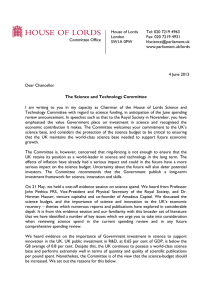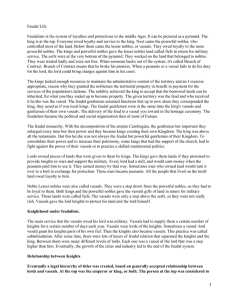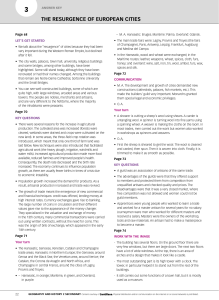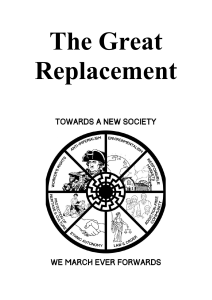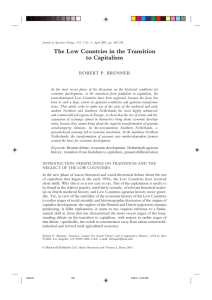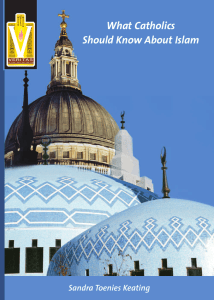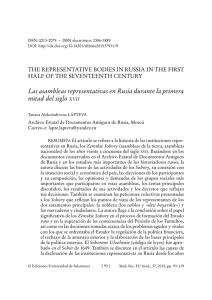The Formation of Europe.
Anuncio
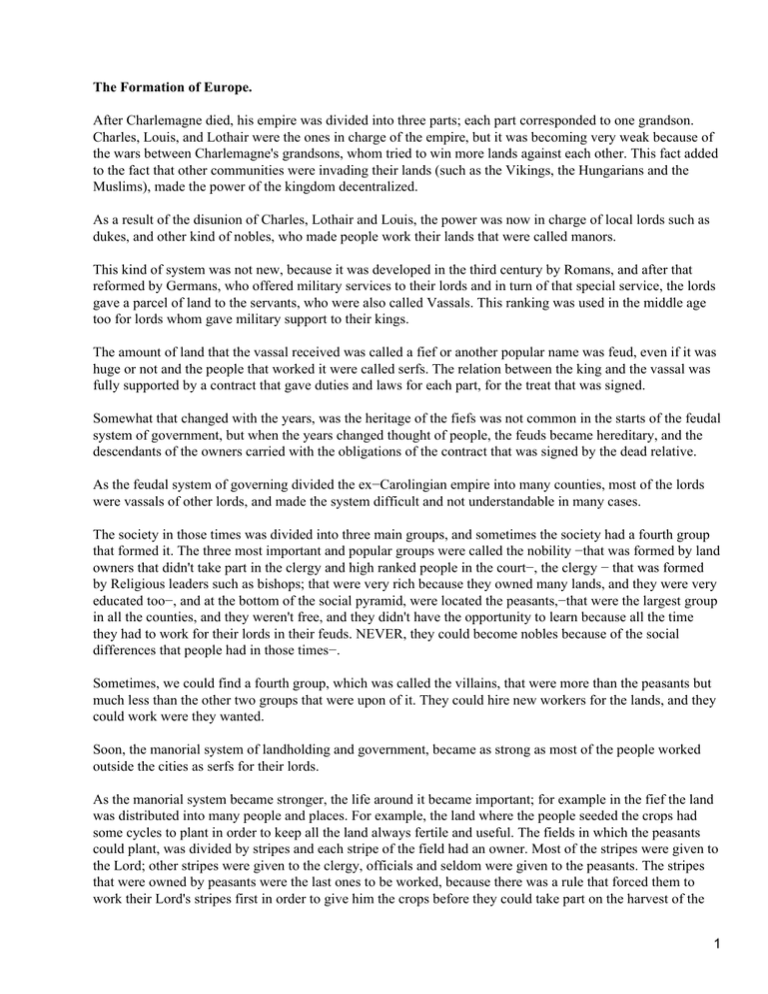
The Formation of Europe. After Charlemagne died, his empire was divided into three parts; each part corresponded to one grandson. Charles, Louis, and Lothair were the ones in charge of the empire, but it was becoming very weak because of the wars between Charlemagne's grandsons, whom tried to win more lands against each other. This fact added to the fact that other communities were invading their lands (such as the Vikings, the Hungarians and the Muslims), made the power of the kingdom decentralized. As a result of the disunion of Charles, Lothair and Louis, the power was now in charge of local lords such as dukes, and other kind of nobles, who made people work their lands that were called manors. This kind of system was not new, because it was developed in the third century by Romans, and after that reformed by Germans, who offered military services to their lords and in turn of that special service, the lords gave a parcel of land to the servants, who were also called Vassals. This ranking was used in the middle age too for lords whom gave military support to their kings. The amount of land that the vassal received was called a fief or another popular name was feud, even if it was huge or not and the people that worked it were called serfs. The relation between the king and the vassal was fully supported by a contract that gave duties and laws for each part, for the treat that was signed. Somewhat that changed with the years, was the heritage of the fiefs was not common in the starts of the feudal system of government, but when the years changed thought of people, the feuds became hereditary, and the descendants of the owners carried with the obligations of the contract that was signed by the dead relative. As the feudal system of governing divided the ex−Carolingian empire into many counties, most of the lords were vassals of other lords, and made the system difficult and not understandable in many cases. The society in those times was divided into three main groups, and sometimes the society had a fourth group that formed it. The three most important and popular groups were called the nobility −that was formed by land owners that didn't take part in the clergy and high ranked people in the court−, the clergy − that was formed by Religious leaders such as bishops; that were very rich because they owned many lands, and they were very educated too−, and at the bottom of the social pyramid, were located the peasants,−that were the largest group in all the counties, and they weren't free, and they didn't have the opportunity to learn because all the time they had to work for their lords in their feuds. NEVER, they could become nobles because of the social differences that people had in those times−. Sometimes, we could find a fourth group, which was called the villains, that were more than the peasants but much less than the other two groups that were upon of it. They could hire new workers for the lands, and they could work were they wanted. Soon, the manorial system of landholding and government, became as strong as most of the people worked outside the cities as serfs for their lords. As the manorial system became stronger, the life around it became important; for example in the fief the land was distributed into many people and places. For example, the land where the people seeded the crops had some cycles to plant in order to keep all the land always fertile and useful. The fields in which the peasants could plant, was divided by stripes and each stripe of the field had an owner. Most of the stripes were given to the Lord; other stripes were given to the clergy, officials and seldom were given to the peasants. The stripes that were owned by peasants were the last ones to be worked, because there was a rule that forced them to work their Lord's stripes first in order to give him the crops before they could take part on the harvest of the 1 planting field. On the other part of the feud, we could find buildings such as the house in which the Lord of the feud lived, that was most of the times a castle, which was built on as place called the demesne, and also there were other types of building such as the church and barns. As in those times a single Lord could have many feud of his own, he could just live and check a feud at the same time, so he hired some people that in the northern countries that used the system of feudalism were called the steward, the bailiff, and the reeve. Each one had the task of checking the fields, but each of them was more important than other. The steward had to check the status of the lands and crops, because they had to travel to the fief in which his lord was located, and had to advise him about the feuds. The bailiff had to check the peasants, the work on the lands; he had to supervise the harvest. At last he had to collect the money that peasants had to pay to the lord, such as taxes, rents and dues. The last one that was the reeve, had to check the hay, and care about the cattle, also he had to check the relationships between the officials and the peasants. In the middles ages, the peasants had to work very hard, taking care of the manor's status, and they had to do all things that the lord wanted them to do, like cut the woods and take care of the cattle and crops. In those times, the women weren't considered less useful than men, they had to do the tasks of the farm everyday, and they had to take care of their children too. On the other hand, the noble women that had a husband that was lord of a manor, had to take care of it while her husband returned to his duties, most of the times, this happened when the lord had to attend to wars. They had to be very faithful with their husbands, and they could hold lands. When they were going to marry, they got married when they were still teenagers, the average age was 14, and the high class girl's parents had to give her a dowry, which was material good that she had for her marriage. In the middle ages, the life in the castles was not very comfortable, the weather was cold, and to get heat in the rooms was almost impossible as there were no chimneys in the rooms, animals couldn't sleep with their owners. There were no rugs so they had to spread straw on the floor to isolate the coldness of the stone. As the castles were continuously attacked, the engineers built tall wall to protect the castle, and they made digs that were filled with water, and threw burning hot oil to the people that tried to attack them from the lower parts. Religion The church became very important in the middle ages, because people found in it salvation when they died. The church created some sacraments based on the communication with God in order to achieve a holy life with him, there sacraments were a kind of laws that the Christians have to achieve in order to obtain the salvation (now days they are still being used); they are: −Baptizing −Confirmation −Penance −Holy Eucharist −Extreme Unction 2 −Matrimony −Holy orders The five first ones were applied to all the people, and the two left were only applied in special cases such as the arriving of other priest to the Christian community. As it had its sacraments, it also had courts to promote the Justice, and the Christianity; it also cared about the religious members of the church and other type of offenses against the beliefs of the church and its members. These types of courts managed the person's trial with the cannon law, which means: The Law of the Christian Church. People that were against the beliefs of the church, were accused of heresy the most of the times ended with excommunication that meant that the person could not received any other sacrament (this was important because the fifth one ratified that you were a good person when you were alive), and expelled from the church and Christian community. After being accused of heresy the person had a special trial, which consisted in the persuasion of the beliefs and thoughts of the accused that attempted to the church. If the judge could not persuade the person accused, the man or woman was sentenced to die burned at the stake attached to a pole. In the Tenth century, the papacy depended of a German for protection against abuses from the nobles. So, between the German noble chief and the papacy arranged that kings could interfere in the election of important positions inside the church, such as popes, bishops, etc. A century later, in a place called Cluny, that today is a zone of France; there was a revolutionary movement that was against the intervention of nobles in the holy elections of the church members, which created a reform that forbade the ale of positions to the nobles, and preventing a possible civil control over the pope that was in charge of the church. Later, in 1058, a school for Cardinals was created in order to make a good election of the new pope, and to be sure that the new pope was going to be elected by the church and not by other hands such as German nobles. As the time passed, the church was becoming stronger and more important than any other institution in the time. The word of the church became as important as that the pope ordered to the King John of England to give all the lands that today are know as England to the papacy, and the pope would return it as a fief. This action made automatically King John a direct vassal of the pope; this rule was also taken in the lands that in those days were known as Denmark, Hungary, Poland and a Spanish kingdom called Aragon. During the centuries eleventh to thirteenth, in Europe appeared two groups of religious groups that preached in small villages and town the importance of Christianity, and offered holy masses. These groups were called the Franciscans and the Dominicans. The first one was founded by Francis of Assisi (famous because of his stigmas), and the second one by Saint Dominic. Both groups made vows of poverty and cared about homeless people in those ages. But returning a little bit in the history, we could find that in the lands that many years ago Jesus lived were now occupied by the Muslims that arrived there in the year 638 A.D. This concerned very much the Church because that land was holy for Christians, but it didn't belong to them even if the Christians were able to visit the places where Jesus lived long time ago. So in the eleventh century the Muslim Turks gained the control of the holy city of Jerusalem (1089), later there was a Turkish threat that said that they were going to conquer Constantinople −in those times the capital of the Byzantine empire−. This threat concerned much the emperor and he asked for urgent help against the Muslim domination. 3 At the late eleventh century −more or less 1095−, the Pope Urban III made a meeting for the nobles that followed Christianity in the city of Clermont (now days France), to discuss about the military support for the Byzantine emperor. When the meeting finished, they decided to create a group of fighters called the Crusaders, that was a group of knights and lords that meant marked with a/the cross. This group of people was elected to fight against the Turks, and to recover part of the holy land of Middle East. As an action in turn, the Pope offered the forgiveness of all the kind of sins, and in the other hand, fighter could get rid of debts and they could obtain the lands conquered as fief. This promise was especially good because the only people that could have fief were the second sons of the lords, just the first ones, but they did become nobles anyway. While in France after the meeting the nobles were organizing their army, preachers from the Christian religion invited peasants to fight against the Muslim power. Aroused by the explicit preaching of the priests and preachers, a very big crowd of peasants decided to go to Jerusalem and kill the Muslims that were winning the power of the holy land. These people killed many people, and their group was known as the Peasant Crusade. Most of the people that these peasants killed were Jews that did not believe in Christ. When they arrived to Constantinople, in the year of 1096, they looted the whole city and burned most of the places of it. When they left Constantinople, they were attacked by Turks and later they were tortured. After this chaotic try, the nobles made it much organized, which included three thousand knight on horse back, and twelve thousand walking. During the last year of the eleventh century, the group of nobles arrived to Jerusalem and massacred people indiscriminately. After that, they divided the conquered land into little states, but like fifty years later, Muslims attacked again these states, and captured again the place that today is Edessa, Armenia. There were disputed other two Crusades that just left poverty, an d the right for the Christians to go to holy land, but the land was still from Muslims. When the last crusade was started, the purpose was not to win lands or fight against the Muslims, it was to sack Constantinople, and kill people. These wars did not give many good things, the only two things that it lest were the commerce between Asia and Europe, and the enrichment of the languages. But if we check all the problems that the wars left, we can find that the worst one was that since then, all Muslims thought that Western people were uncivilized and rude. As the commerce between the two continents increased, the size and population of cities also did. As Italian merchants traveled through the Mediterranean, they collected many things in other harbors, for example they carried goods from France to be bought in England. This made merchants wealthy and rich. And as trade grew, cities did so. Another important fact was that the use of money became popular in these years, because before the system worked with the barter, that was to exchange services or products for others that you needed. Nobles helped in the evolution of the commerce because they arranged annual fairs that contributed to the enrichment of merchants, and now, another kind of job: money exchanger. This job consisted in the exchange of foreign money into local money that helped the foreigners − this job was considered a sin by the church−, and it made them earn a little fee, that made them survive, and with the years turn wealthy. There was an easier way to handle the money, which was the system of the credit that let merchants transport big amounts of money by safer ways. These ways of financial interaction with the society made the commerce faster and made cities big center of interaction and gave the principles of today's banking. Other big step that medieval society made was the improvement of the technological inventions for agriculture, such as the collar, the harness, and the horseshoes. The new ways of seeding and harvesting helped out the population to become wealthier, and prosperous. As the harvest was being exported, the merchants made the cities bigger, and as well as prosperous, crowded. The lords needed more workers everyday because they usually drained swamps, cleared forests or used land from the sea for harvesting, because they needed to build dikes, or bridges, and make the earned land fertile. To gain more workers, the lords offered them special rights, that centuries ago, the serfs did not, such as freedom, and the possibility to 4 live in the city, or in the manor. This right made the cities crowded, but it obtained stability. Moist of the people preferred now to live in the city than in the manor. Serfs that did not want to continue working as serfs could be craftsmen or craftswomen. These kinds of jobs made prosper the life in the city. As the cities became overcrowded, the sanitary situation of the city became unhealthy too, and people were vulnerable to strong plagues. Also as most of the houses were made up of wood, they were easily burnable by rays, or by the fire used inside the house to maintain it warm. Anyway people didn't care about those dangers in order to survive and make money. Even if people made sanity rules, in 1347 an epidemic of bubonic attacked Europe by the southeastern part, more or less by Constantinople, and it was spread by the merchants that traveled through all Europe. Soon, this plague had devastated with much part of the population of medieval Europe. This plague was commonly called the Black Death, because the corpses of the ills became darkish. As most of the people were sick, the food scarce because there were no active people to harvest. Years later, people discovered that this terrible plague came from a flea that lived in the black rats. This epidemic helped somehow to the serfdom, because the small amount of people that survived, were able to receive higher wages, and get independence from the feud. When the plague ended, the population of the European cities was very few, but they slowly recovered their population. The commerce became again a powerful source of advance in the society. With this fact, in the society pyramid appeared another class of people that made up the bourgeoisie, which had a higher rank than the serfdom, but it was still less important than the nobility. It had it's origins in the medieval towns, burg means town. It was a tradition to look down upon to less important classes. We can find here that the towns had an institution called guild, which regulated the exportations, and the competition of other exporters. This institution also monopolized the trade, so they settled some rules to let merchants trade their merchandising. These kinds of institutions helped homeless people to get a house and help in the development of social events. Coming back to the eleventh century, we could observe that foreigners were well received in the kingdoms because they brought gossips and news from other places. Also they could believe in their faith, so they free election of religions was not forbidden at all. Most of the Jews that lived in Europe, educated their sons with the Holy Bible, and the Talmud or Torah, and the Jews were very intelligent and educated, because most of them could read and write, something that not all the nobles knew how to do it. After the crusades, most of the nonconformists blamed the Jews about the responsibility of the crusades, and about the Black Death that whipped Europe. They were banned, and they were expelled of Germany, France, and England, because they were seen as sinners, because they had to become money lenders as they had no possibility to work in a good job. In those times the money lending was seen as a sin, but after the banking was invented, it was like a gift for humanity. As now the Jews had no home, countries such as Italy, Poland and The Netherlands offered residence to those displaced people. Education During the middle age many factor made that the learning because important and useful in those day. For example, the wealth ness that the bourgeoisie obtained made important the construction of new centers of learning, and other important factor was the reforms from the church, and another fact that contributed was the contact with Asia and its civilizations. As life in the cities became everyday more difficult, the civil governments and the Church needed trained people that could help them in specific topics. Teachers and students that wanted to help both governments needed to meet, and by the way form a group called University. The first universities were created in Bologna, Italy, and Paris, France during the years 1158 and 1200 respectively. Each one taught a different cathedra, and the places in which they studied were not very comfortable, they had no chairs, and they had to study for long hours. They could hire their teachers, and 5 make their own rules. The time that they could study was just between the hours that the sun was shining, because the candles were very expensive, and they did not have any other way of lightning. Saint Thomas of Aquinas was one of the most questioned students in the history of theology, because his thoughts were not accepted by the nobles, and high ranked people in the Church guild. The interaction with the Middle East helped very much in the technological advances that were invented centuries ago. For example the compass helped very much the sailors, and the mathematics helped very much the people in those times in order to count, and operate with amounts, as well as geometry, trigonometry, algebra, and calculus. Arabs contributed in the study of medicine and the sciences of the health. People that lived long time ago had many thoughts about the possible future, for example Roger Bacon that was an English monk; firmly believed that one day machines were going to be better and more efficient than man and the animals. As a result of his fantasies, he was declared guilty of heresy, and he had to spend 15 years in jail before his works and investigations became condemned. Latin was a way of communication between educated people in the middle ages, and it was supposed to be the language in which the world had to speak, but its difficulty made locals to speak in their local and common language such as old Spanish, French, Italian, Portuguese. This group of languages was called the Romance Languages, which were based on Roman Latin words. Another group of languages was the group of the Germanic languages, such as modern German, English, Dutch and other Scandinavian languages like Swedish, Danish and Norwegian. Invasions made that several words mixed with other languages and they where adopted by that language. If we compare some words of romance languages, we can see that they are very similar to other words in English or as it was known centuries ago; Anglo−Saxon, because their roots come from Latin words. As a result of the development of new languages, new writers became important and made great poems that related stories of heroes such as the Beowulf. As the bourgeoisie could now read and write, they were interested in the popular stories, and this let early writes succeed. Writers such as Dante Alighieri and Geoffrey Chaucer wrote about journeys in which people passed through hell, or traveled in England. Their most important works were The Divine Comedy, and The Canterbury Tales. Another kind of art was the drama, which represented parts of the Bible, and helped people that couldn't read and write. Another way to introduce people into the Christian belief was to paint passages of the Bible in order to help people visualize what they believed in. This way of support to the art made new ways of art such as stained−glass, now days found in most of the cathedrals in the European cities. END. 6
